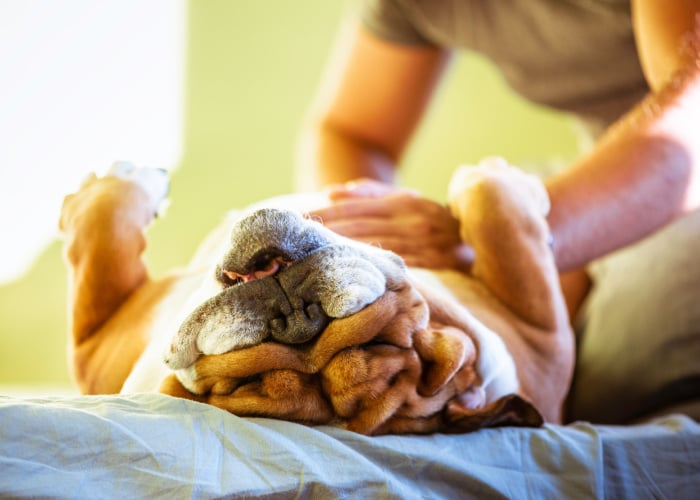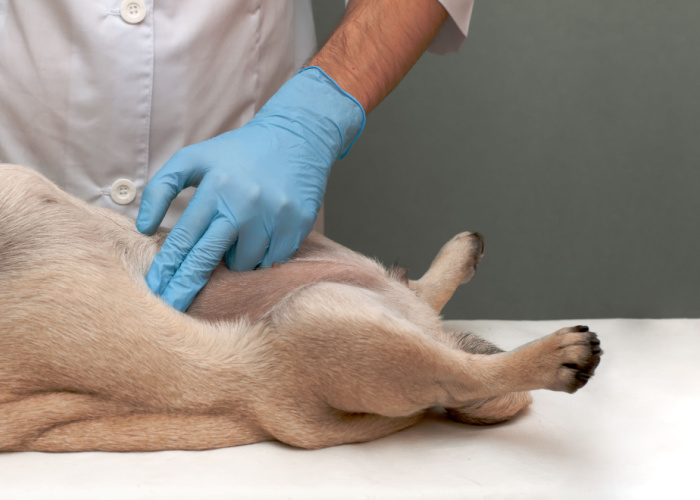
Table of Contents
- Home Remedies for Paraphimosis in Dogs: 7 Simple Steps How to Get Dogs Unstuck
- Important Reminders for Dog Paraphimosis Home Treatment
- Vet Treatments for Paraphimosis in Dogs
- How to Prevent Paraphimosis in Dogs
- Paraphimosis in Dogs: Definitely Not Something to Be Embarrassed About
- Home Remedies for Paraphimosis in Dogs: FAQs
- Home Remedies for Paraphimosis in Dogs: Before You Go…
Ever noticed your dog's red rocket sticking out?
Well, it’s a normal thing that your male furballs do when in heat.
But beware hooman:
It’s a health concern when your dog’s red thing sticks out for a long time.
Paraphimosis in dogs isn’t a fancy or technical term for this seemingly embarrassing phenomenon in your Fidos.
When you notice this condition in your dogs, Dr. Patrick Mahaney warns that:
The more he licks or claws down there, the more likely he is to induce trauma. I wouldn’t wait until it’s hanging like a lychee fruit.
At Top Dog Tips, we strongly encourage you to always seek your vet’s professional advice.
And at the same time, we’re committed to providing you with the most reliable and science-backed information possible.
So, in this blog, I'll talk about home remedies for paraphimosis in dogs using the most common kitchen staple — sugar!
Yup, that’s according to a study by Autumn P. Davidson, DVM, MS, DACVIM of the Department of Medicine and Epidemiology, School of Veterinary Medicine at the University of California.
I pretty much scoured the corners of the Internet and summarized everything, so you don’t have to.
So, let’s dive in, shall we?

Home Remedies for Paraphimosis in Dogs: 7 Simple Steps How to Get Dogs Unstuck
Note: This process may work depending on the severity of the condition. So, it’s best to consult your vet immediately.
If, in any circumstance, you can’t see a vet, you can take note of the following paraphimosis home treatments for your dogs in the meantime.
Cold Water and Sugar Solution (or Paste)
The sugar paste works as a hyperosmotic agent that pulls out fluid from the tissues and shrinks them.
So, follow these simple steps to get your dog’s private part unstuck.
Step 1: Clean the exposed penis with water thoroughly.
Step 2: Check for any foreign materials like long fur that might have been choking or restraining your dog’s penis. Remove immediately, if any.
Step 3: Make a thick slurry using white sugar (granulated is fine) and cold water. Mix until paste-like consistency.
Step 4: Soak a clean washcloth in the solution.
Step 5: Gently wrap your dog’s penis with the soaked washcloth.
Step 6: Get a light towel and wrap a bag of frozen peas in your dog’s private area every 5 minutes.
Note: This helps decrease the swelling of the tissues.
Step 7: Apply lubricants (personal, sterile surgical, moisturizing lotion, or K-Y jelly) on the area and gently slide the penis back into the sheath.
RELATED: Dog Humping: Why Does My Dog Hump?
Important Reminders for Dog Paraphimosis Home Treatment
1. Be Gentle and Do Your Best Not to Excite the Dog Any Further
Sometimes, the bulbourethral gland is swollen due to the dog getting excited.
It can also take time for the blood to exit the gland, allowing it to shrink.
If you think the penis swelling has somewhat relaxed or decreased, you can try gently pulling the prepuce over the penis.
The prepuce in dogs is the skin and other tissues that surround the non-erect penis.
2. Do Not Force Your Dogs if They’re Uncomfortable
Some dogs may not like the idea of having their private area examined.
This is why vets typically sedate your dogs in case of paraphimosis.
Putting pressure or forcing your dogs can only tense their body, worsening the condition.
3. Take Your Dogs to the Vet
If the swelling continues within 30 minutes and your dog’s penis doesn’t stay retracted into the prepuce, seek professional assistance immediately.
In severe cases, your dogs can be partially amputated due to loss of blood supply in the penis’ tissues.
RELATED: 5 Embarrassing Dog Health Concerns

Vet Treatments for Paraphimosis in Dogs
If your dog’s penis is still sticking out for a long period of time, home remedies can no longer be practical.
Paraphimosis in dogs shouldn’t be left untreated in order to prevent the condition from worsening, such as the following:
- Penis and foreskin scarring
- Abscess or pus on penis or foreskin
- Necrosis or death of penile tissues and cells
Vet treatments can vary depending on the status of the condition.
Below are typically what your vets administer on your dogs suffering from paraphimosis or their red rockets sticking out.
1. Hypertonic or Osmotic Solution
Your vet can sometimes apply hypertonic or osmotic solutions (like the sugar paste) to the penis to relax the swelling so that it can return to the sheath.
Hypertonic solutions are used by clinicians to reduce edema or swelling caused by too much fluid trapped in the body's tissues.
2. Surgery
In a more severe case, an exploratory surgical procedure can be done by vets to cut the prepuce in order to create a larger opening to let the penis return to its normal placement.
3. Catheter Placement
If the urethra is damaged, temporary placement of a urinary catheter may be needed to prevent stricture formation.
A stricture involves the narrowing of the tube that carries urine out of your dog’s body, making it difficult to pee.
4. Analgesic (Pain Relievers)
Paraphimosis in dogs can be very painful, especially in severe conditions. Vets typically administer analgesics to your dogs to help relieve pain.
5. IV Fluid Therapy
Vets can administer fluid therapy to your dogs for the following reasons:
- Maintain normal hydration
- Replace dehydration deficits
- Replace essential electrolytes and nutrients
- Serve as a vehicle for the infusions of certain intravenous medications
According to Michael Schaer, DVM, DACVIM, ACVECC of the University of Florida, College of Veterinary Medicine:
The methods for providing fluids often influence the eventual outcome of the case.
Especially for critically ill dogs suffering from paraphimosis, fluid therapy is crucial.
6. Partial Penile Amputation
In unfortunate and severe cases, your dogs have to undergo penile amputation or a surgical procedure to remove the penis.
This procedure is considered a last resort to save some of the function of the penis for urinary purposes.
A study finds that partial penile amputation saved the lives of dogs with chronic paraphimosis.
RELATED: 5 Causes and Signs of Prostate Problems in Dogs

How to Prevent Paraphimosis in Dogs
This medical concern may only be occurring in male dogs, but it isn’t necessarily breed-specific.
So, when you have furry boys at home, be sure to practice proper preventive care like the following:
1. Keeping the Hair at the Tip of the Prepuce Short
This reduces the likelihood of hair sticking to your dog’s penis.
You can use electric trimmers or hair clippers to carefully cut the hair from the prepuce.
A scissor may be used when trimming hair, especially in very sensitive areas.
Just be careful not to cut the skin.
Note: Trendy, artistic hairstyles at the tip of the prepuce, like the Merkin cut, can contribute to penile issues and infection.
2. Promoting a Healthy Hygiene
Maintaining good hygiene for your pets doesn’t have to be fancy and expensive.
Good-quality antiseptic wipes or a quick rinse in running water will do just fine.
As you may know, dogs typically self-clean their genitals, but overdoing it can cause infections, too.
So, a checkup from your vet is best done regularly to ensure your pup’s reproductive health.
3. Keeping Your Dogs From Excessively Licking Their Privates
Commonly referred to as the “cone of shame,” the Elizabethan collar helps keep your dog from licking its genitals, especially when undergoing treatment.
4. Giving the Right Kind of Food
A nutritionally balanced diet is a must for your dog to prevent paraphimosis from possibly occurring.
While a fresh diet is preferable, commercial foods with high-quality, natural ingredients and no artificial additives are also a great option.
Meanwhile, a raw diet or home-cooked meals that are packed with the following components are also vital:
5. Neutering
For dogs not used for breeding, vets typically recommend neutering them to avoid arousal or erection of the private part.
Neutering is also advised for dogs that experience phimosis, the opposite condition of paraphimosis.
Fact: Phimosis is the inability of the penis to protrude or extend.

Paraphimosis in Dogs: Definitely Not Something to Be Embarrassed About
Paraphimosis is not a rare condition in male dogs. So, getting a good glimpse of this phenomenon is vital for pup owners.
What is Paraphimosis in Dogs?
Paraphimosis is the prolonged inability of dogs to retract their penis back into its normal position within the preputial sheath after mating or erection.
This sheath is the protective covering that keeps your dog’s red rocket under wraps.
When your dog’s private part is stuck out of the sheath (or prepuce) and usually appears quite swollen, it’s considered a true emergency.
If the swollen penis remains trapped outside the sheath, it can:
- Become necrotic (die)
- Slough or cast off from the skin
- Cause systemic infection (sepsis)
Why Do Dogs Get Stuck?
You may have noticed your dog’s red thing erected at some point, especially when reaching maturity or in heat.
Does maturity have something to do with paraphimosis in dogs?
Technically, yes.
According to an interview with Holistic Housecall Veterinarian Dr. Patrick Mahaney:
Even though he [the dog] was neutered, he would still be producing testosterone.
If you put a male and a female dog in heat together, the former will still “try to get with her.”
So, sexual excitement is the most common cause.
However, paraphimosis in dogs can also be due to the following factors:
- Tumor
- Chronic licking
- Penile injuries or trauma
- Foreign bodies under the skin
- Hair wrapped at the base of the penis
- Congenital deformity of the penis or prepuce
- Neurological problems (rupture of a disc in the spinal cord)
Symptoms of Paraphimosis in Dogs
Apart from your dog’s penis sticking out, here are other symptoms to take note of:
- Smelly discharge
- Excessive licking of the area
- Trouble mating and/or urinating
- Visible swelling and redness of the penis
- Posthitis (swelling of the foreskin of the penis)
How Do Vets Know When Dogs Have Paraphimosis?
If you suspect paraphimosis in your dogs but are unsure about the symptoms, your vet will perform a physical exam, including additional tests like the following:
Neutrophil Count
Neutrophils are a specific type of white blood cells in dogs that help fight infections.
If your dog’s neutrophil count is high, it often indicates an infection or cancer.
To determine your dog’s neutrophil level, a Complete Blood Count (CBC) and peripheral blood smear are done by your vet.
Once these tests are done and if there’s a need for further diagnosis, your vet may perform other procedures like:
- Flow cytometry
- Bone marrow biopsy
- Molecular/genetic testing
Stress Leukogram
The leukogram is part of the CBC that examines white blood cells, which includes the total number of the following:
- Basophils
- Monocytes
- Neutrophils
- Eosinophils
- Lymphocytes
According to clinical pathologist Dr. Sarah Schmidt, DVM, DACVP:
The term stress denotes the presence of increased cortisol released from the adrenal gland secondary to severe disease.
Dr. Schmidt also suggests that stress in dogs can also be due to:
- Pain
- Dehydration
- High body temperature
Serum Chemistry Profile
This routine diagnostic test is performed by your vets for the following reasons:
- Investigation of clinical signs
- Confirmation of clinical suspicions
- Monitoring patient response to treatment
The Serum Chemistry Profile is composed of a series of tests done through in-house testing, vet reference, and/or diagnostic laboratories.
Home Remedies for Paraphimosis in Dogs: FAQs
Does paraphimosis hurt my dog?
Paraphimosis in dogs can hurt, especially when left untreated.
If your dog’s red rocket is stuck out for a long time, it can dry out and swell around the private area.
In some cases, dogs with paraphimosis have difficulty urinating.
How do vets treat paraphimosis in dogs?
Vets treat paraphimosis in dogs depending on the severity of the condition.
Surgery is typically done when the dog’s condition worsens.
Meanwhile, vet treatments of paraphimosis (like neutering) also depend if your dog is used for breeding or not.
Can you cure paraphimosis in dogs without surgery?
Paraphimosis is curable without surgery, especially if the condition is mild.
Other vet treatments apart from surgery include hypertonic solution, lubricants, fluid therapy, pain relievers, or catheter placement.
However, neutering can be done for dogs that are not used for breeding.
Is there any medicine for paraphimosis in dogs?
Medicines for paraphimosis in dogs include analgesics for pain relief and anti-inflammatory treatments.
To clean your dog’s private area in cases of wounds and infections, diluted antiseptic solutions are also used, such as chlorhexidine or povidone-iodine.
However, it’s best to consult your vet when your dogs experience paraphimosis.
Does paraphimosis in dogs heal?
Paraphimosis in dogs can heal, especially if treated early.
With proper medication and prevention, your dog’s main reproductive organ can function normally again.
However, treatments will vary depending on the severity of the condition.
Home Remedies for Paraphimosis in Dogs: Before You Go…
Paraphimosis in dogs is a true pet emergency rather than something to be ashamed of.
It may be normal for your dog's red rocket to stick out when aroused, but not if it lasts for more than 30 minutes.
Paraphimosis home treatment in dogs can be a great first aid.
But in severe conditions, these home remedies for paraphimosis in dogs can be deemed impractical.
So, be sure to pay your vet a visit when you notice this phenomenon in your pups.
Find this blog helpful?
You might find our top recommendations below interesting!












